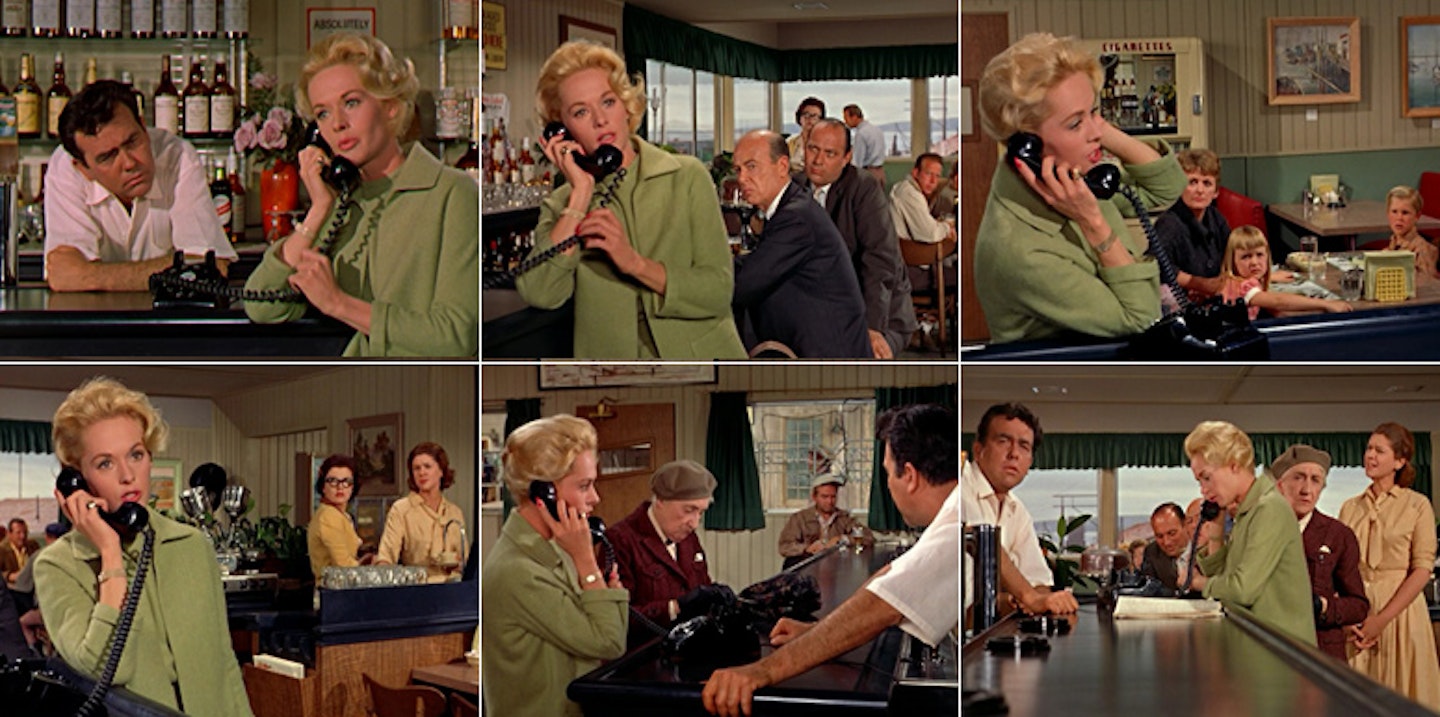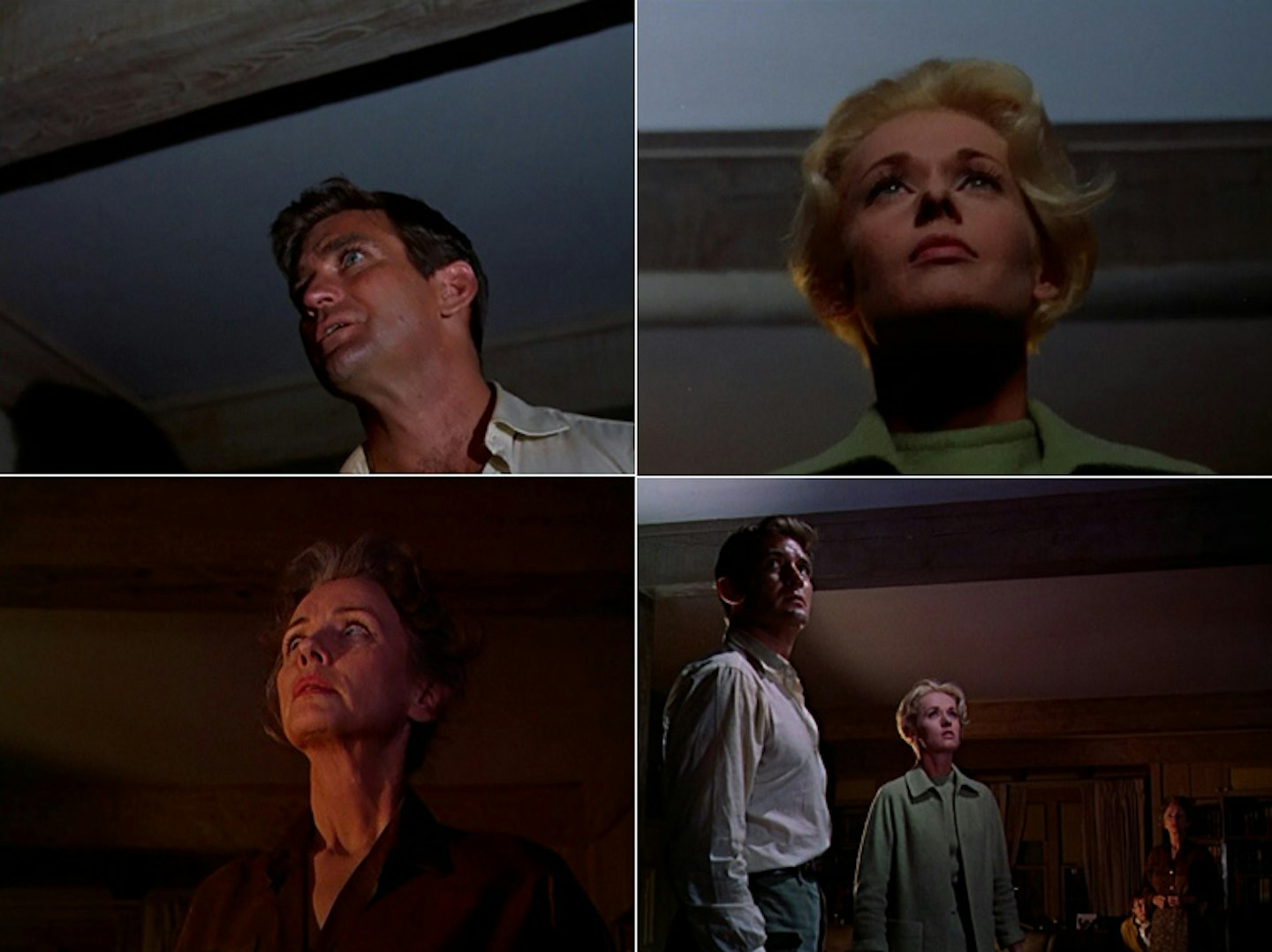Alfred Hitchcock's The Birds premiered on March 28, 1963. Ostensibly a gentle rom-com about a socialite, Melanie Daniels (Tippi Hedren), and a lawyer, Mitch Brenner (Rod Taylor), it soon becomes an all-out horror when their courting is interrupted by violent, unexplained bird attacks. Its ambiguity and subtext have been hotly debated since its release, but one thing most agree on is that The Birds contains some of Hitchcock's most inspired imagery. To mark the film's 50th birthday, we examine some of its remarkable visual moments, and look at how the Master employed the tools at his disposal to evoke specific emotions, create certain effects and generally demonstrate his all-round genius...
Having already aimed a pointy beak at Melanie's head and mounted an all-out assault on Mitch's little sister Cathy’s (Veronica Cartwright) birthday party, the birds' third attack arrives unexpectedly and with eerie menace. Melanie and the Brenners are enjoying a spot of afternoon tea, while Cathy's pet lovebirds are making steadily more and more noise in the background. As the only non-violent birds in the film, are they trying to warn the Brenners of something? A curiously high-angled close-up of Melanie (foregrounding the spot on her head where she was attacked), paired with sudden silence, unsettles us, and a single finch appears on the hearth. And then: carnage. Thousands of finches, buntings and swallows pour out of the fireplace and attack the family. The switch from domestic banality to unbelievable terror is deftly controlled by Hitchcock, giving us a few uneasy seconds to realise something's up before unleashing the full horror.
Trivia titbit: Most of the birds in this scene were added in using a "yellow screen" process at Disney. An attempt to use live birds on set was abandoned when they were released from the chimney and proceeded to behave in an entirely non-threatening manner, standing around and wondering why everyone looked so cross.
Mitch’s mother Lydia (Jessica Tandy) pops over to Dan Fawcett's farm to have a word with him about his rubbish bird feed. There's no answer, so she lets herself in. Guessing something's up when she spots broken crockery in the kitchen, Lydia creeps slowly towards Dan's bedroom in silence, where she finds all manner of bird-based devastation. Most unsettlingly, though, she discovers Dan's body, horrifically lacking in eyeballs to the tune of two. Hitchcock takes us uncomfortably close to the sightless corpse in three quick shots, each tighter than the last. If anything, it's the quiet that's most unnerving. This is the kind of scene that would have employed shrieking violins in Psycho, but here Hitch plays it all out in terrifying silence.
Trivia titbit: Dan's hollow eye sockets are actually a combination of makeup effects and miniature matte paintings, with the blackness and surrounding blood painted in by an artist.

This one's not easy to spot, but it's a very deliberate touch in which Hitchcock uses more than just quick cuts and screaming actresses to convey emotion. Watch carefully as Lydia's truck drives up to Dan Fawcett's farm: oblivious to the horror which awaits her, she pootles up the drive with all the speed of, well, an old lady off to natter about bird feed. Skip forward two and a half minutes, during which time both Lydia and the audience have had a trouser-troubling experience with Dan's empty eye sockets, and she races away from the farm in a near-identical shot to her approach - except that this time her truck kicks up huge clouds of dust, implying manic speed and panicked urgency. It's illogical in retrospect (why wasn't there any dust when she arrived?), but Hitchcock didn't deal in logic; he dealt in cinema.
Trivia titbit: To achieve the desired effect, Hitchcock shot the dusty exit shot first, then had the road dampened before shooting the arrival.
Perhaps the most famous sequence in The Birds is the 'jungle gym' scene, in which Hitchcock builds suspense through innovative editing. Waiting to meet Cathy from school, Melanie sits in front of the playground and enjoys a crafty fag. A single crow lands on the climbing frame. Hitchcock cuts between increasingly tighter shots of Melanie and shots of the climbing frame, each time adding more birds. Having set up this pacy rhythm, he then confounds expectation by sitting on a close up of Melanie for nearly 30 seconds, during which the audience is tearing their hair out waiting to see how many birds have amassed behind her. The reveal is magnificent and terrifying, and made even creepier by the bizarre nursery rhyme the school kids are chanting in the background.
Trivia titbit: Most of the birds in the final shot are dummies or cardboard cut-outs. Hitch figured that if a few of them were alive and moving, the audience would believe they were all the real deal.

Sticking two podgy fingers up to over six decades of accepted filmmaking traditions, Hitchcock shot and edited the scene in the Tides restaurant with wilful abandon. Visually pepping up what is essentially a lengthy exposition scene featuring a woman on the phone, Hitch shoots from a multitude of different angles and edits them together in unconventional fashion. With Melanie the focus of every shot, the shifting backgrounds draw attention to the occupants of the Tides as they listen in disbelief to her story. The device works to pull the Bodega Bay residents in towards Melanie, as it gradually becomes apparent that she's at the centre of the birdstorm.
Trivia titbit: Scriptwriter Evan Hunter, who would eventually virtually disown The Birds, felt that this was his best scene, modestly commenting: "Good writing, solid dramaturgy, and splendid acting when it was finally shot".
The attack on the Bodega Bay gas station is a sequence familiar to film students the world over. The actions of a single bird result in a stream of gasoline heading from a petrol pump towards an unwitting cigar smoker, whose discarded match proves that smoking really is very bad for your health. As the stream catches fire, Hitchcock cuts between near-static shots of Melanie watching, and the fire trail racing back towards the petrol pump. Each shot is fractionally shorter than the previous one, building up to the explosion not just with a clinical rise in tension but also in an experimental juxtaposition of movement (the flame) and stasis (Melanie's face). The sequence is topped off by a leisurely, insanely high-angle shot showing the birds observing the carnage with dispassionate menace, before they descend on the town to wreak further havoc.
Trivia titbit: Hitch calculated this short sequence with military precision: from the first shot of Melanie looking off screen (20 frames long), each successive shot is two frames shorter. The final shot of Melanie in the sequence is just eight frames long.

After a prolonged but ultimately unsuccessful attempt to peck their way into the Brenners' house again, the birds apparently give up. Their screeching and squawking dies down, and all becomes calm. Hitchcock contrasts the frantic style of the preceding siege with three beautiful, low angle shots which each begins with an oppressive ceiling (the protagonists are frequently trapped in their own 'cages': a car, a phone booth, a house). Into each shot step the characters: Mitch from the right, Melanie from the left and Lydia from the centre. The camera tracks back from Lydia's close up to reveal all three, plus Cathy, in a carefully staged and lit tableau. The attack is over. OR IS IT? (Spoiler: it's not)
Trivia titbit: Knowing he'd be adding the bird sound effects later, Hitchcock had a musician play an increasingly frantic drum roll off camera to help his actors feel the mounting tension of the scene.
In an ingenious shot, Hitchcock achieves the apparently impossible by tracking his camera backwards through a closed door. Designed purely to get round a practical problem rather than to convey a specific emotion (although you could argue it adds to the surrealism of the story), it's nevertheless worth close inspection. Hitchcock had Rod Taylor reach towards camera, just out of shot, and mime opening a door. A light reveals the previously silhouetted actors, a sound effect of an opening door is added, et voilà! The tracking shot is maintained.
Trivia titbit***: "Aren't you gonna know there's no door there?" Veronica Cartwright asked her director. "But how would I be able to see you?" Hitchcock replied, simultaneously baffling and delighting his 13 year-old star. "That's the magic of movies."

A thing of apocalyptic beauty, The Birds' last shot is also a technical marvel for its time. Hitchcock said it was the most complex shot of the film and, indeed, his entire career: unsurprising when you consider that it called for 32 separate exposures. Although it looks like thousands of birds watching Melanie and the Brenners abandoning home and heading for the faint light of a more hopeful place, in fact it's the same small group of birds shot several times. Set against a doomy, gloomy matte painting by visual effects artist Albert Whitlock (who painted many of the film's most memorable landscapes), the ambiguous ending is one of cinema's greatest.
Trivia titbit: Other endings were mooted: Evan Hunter wrote one which had the car attacked by birds once more, while Hitchcock contemplated another which included a final shot of the Golden Gate Bridge covered in feathered bastards. We presume he abandoned that one because he didn't want to have to scrub millions of gallons of bird shit off the bridge.